2007 CHEVROLET EXPRESS PASSANGER heating
[x] Cancel search: heatingPage 141 of 458

Instrument Panel Overview........................ 144
Hazard Warning Flashers.......................... 146
Other Warning Devices............................. 146
Horn.......................................................... 146
Tilt Wheel.................................................. 147
Turn Signal/Multifunction Lever.................. 147
Turn and Lane-Change Signals................. 148
Headlamp High/Low-Beam Changer.......... 149
Flash-to-Pass............................................ 149
Windshield Wipers..................................... 150
Windshield Washer.................................... 151
Cruise Control........................................... 151
Exterior Lamps.......................................... 155
Headlamps on Reminder........................... 156
Daytime Running Lamps (DRL)................. 156
Instrument Panel Brightness...................... 157
Dome Lamps............................................. 157
Dome Lamp Override................................ 157
Entry Lighting............................................ 158
Exit Lighting.............................................. 158
Reading Lamps......................................... 158Battery Run-Down Protection..................... 158
Accessory Power Outlet(s)........................ 158
Ashtray(s) and Cigarette Lighter................ 159
Climate Controls......................................... 160
Climate Control System............................. 160
Outlet Adjustment...................................... 162
Rear Heating System................................ 163
Rear Air Conditioning and Heating
System.................................................. 164
Warning Lights, Gages, and Indicators..... 166
Instrument Panel Cluster........................... 167
Speedometer and Odometer...................... 168
Trip Odometer........................................... 168
Safety Belt Reminder Light........................ 168
Passenger Safety Belt Reminder Light....... 169
Airbag Readiness Light............................. 169
Airbag Off Light......................................... 170
Passenger Airbag Status Indicator............. 172
Charging System Light.............................. 174
Voltmeter Gage......................................... 175
Section 3 Instrument Panel
141
Page 145 of 458
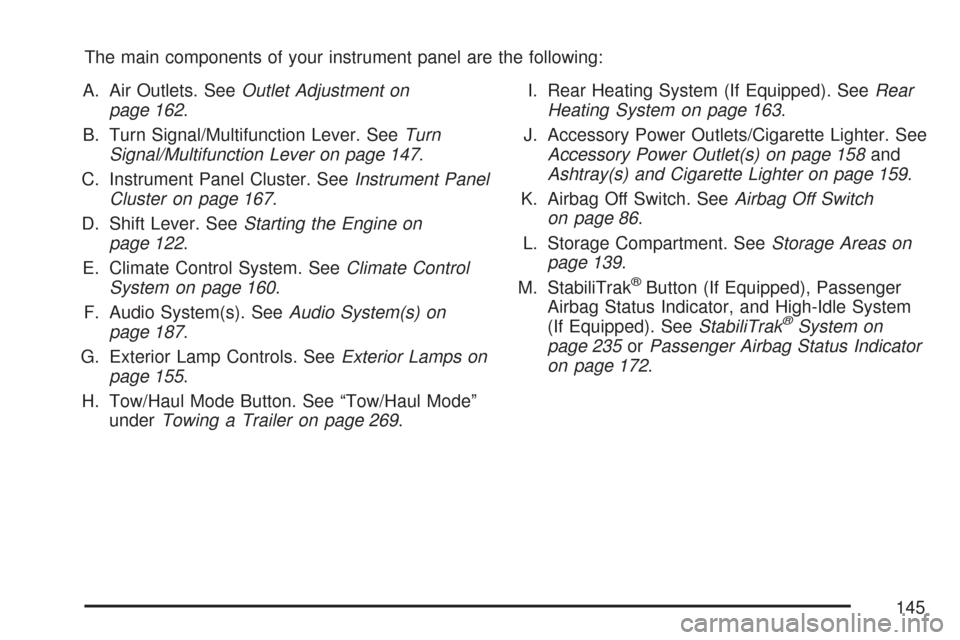
The main components of your instrument panel are the following:
A. Air Outlets. SeeOutlet Adjustment on
page 162.
B. Turn Signal/Multifunction Lever. SeeTurn
Signal/Multifunction Lever on page 147.
C. Instrument Panel Cluster. SeeInstrument Panel
Cluster on page 167.
D. Shift Lever. SeeStarting the Engine on
page 122.
E. Climate Control System. SeeClimate Control
System on page 160.
F. Audio System(s). SeeAudio System(s) on
page 187.
G. Exterior Lamp Controls. SeeExterior Lamps on
page 155.
H. Tow/Haul Mode Button. See “Tow/Haul Mode”
underTowing a Trailer on page 269.I. Rear Heating System (If Equipped). SeeRear
Heating System on page 163.
J. Accessory Power Outlets/Cigarette Lighter. See
Accessory Power Outlet(s) on page 158and
Ashtray(s) and Cigarette Lighter on page 159.
K. Airbag Off Switch. SeeAirbag Off Switch
on page 86.
L. Storage Compartment. SeeStorage Areas on
page 139.
M. StabiliTrak
®Button (If Equipped), Passenger
Airbag Status Indicator, and High-Idle System
(If Equipped). SeeStabiliTrak
®System on
page 235orPassenger Airbag Status Indicator
on page 172.
145
Page 159 of 458
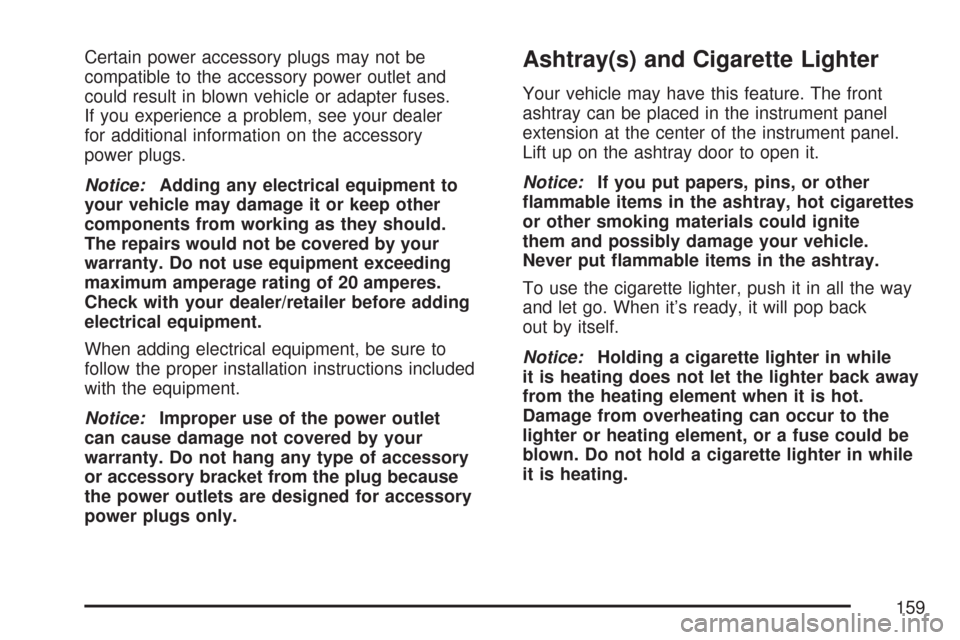
Certain power accessory plugs may not be
compatible to the accessory power outlet and
could result in blown vehicle or adapter fuses.
If you experience a problem, see your dealer
for additional information on the accessory
power plugs.
Notice:Adding any electrical equipment to
your vehicle may damage it or keep other
components from working as they should.
The repairs would not be covered by your
warranty. Do not use equipment exceeding
maximum amperage rating of 20 amperes.
Check with your dealer/retailer before adding
electrical equipment.
When adding electrical equipment, be sure to
follow the proper installation instructions included
with the equipment.
Notice:Improper use of the power outlet
can cause damage not covered by your
warranty. Do not hang any type of accessory
or accessory bracket from the plug because
the power outlets are designed for accessory
power plugs only.Ashtray(s) and Cigarette Lighter
Your vehicle may have this feature. The front
ashtray can be placed in the instrument panel
extension at the center of the instrument panel.
Lift up on the ashtray door to open it.
Notice:If you put papers, pins, or other
�ammable items in the ashtray, hot cigarettes
or other smoking materials could ignite
them and possibly damage your vehicle.
Never put �ammable items in the ashtray.
To use the cigarette lighter, push it in all the way
and let go. When it’s ready, it will pop back
out by itself.
Notice:Holding a cigarette lighter in while
it is heating does not let the lighter back away
from the heating element when it is hot.
Damage from overheating can occur to the
lighter or heating element, or a fuse could be
blown. Do not hold a cigarette lighter in while
it is heating.
159
Page 160 of 458
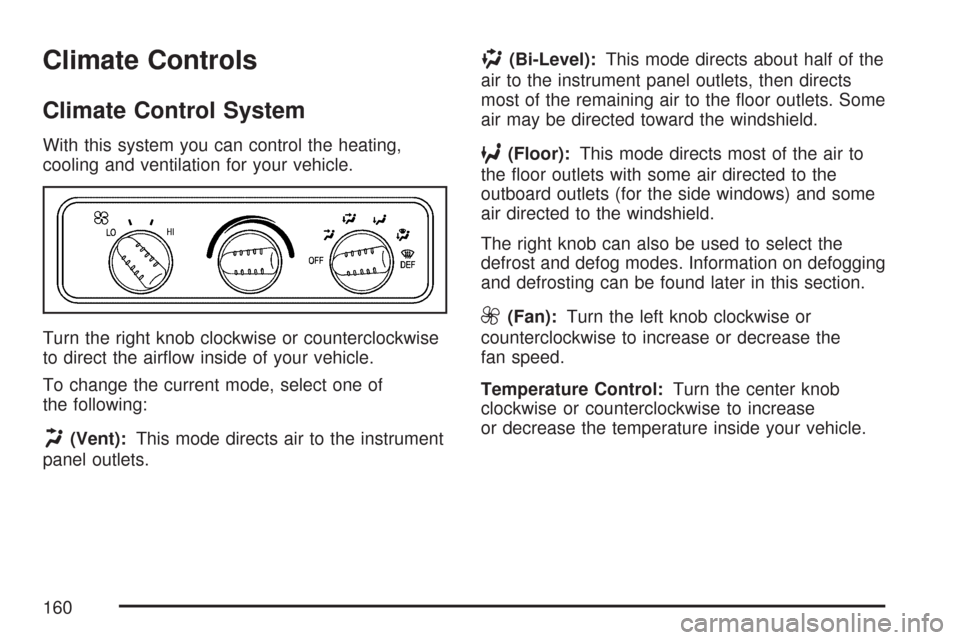
Climate Controls
Climate Control System
With this system you can control the heating,
cooling and ventilation for your vehicle.
Turn the right knob clockwise or counterclockwise
to direct the airflow inside of your vehicle.
To change the current mode, select one of
the following:
H(Vent):This mode directs air to the instrument
panel outlets.
)(Bi-Level):This mode directs about half of the
air to the instrument panel outlets, then directs
most of the remaining air to the floor outlets. Some
air may be directed toward the windshield.
6(Floor):This mode directs most of the air to
the floor outlets with some air directed to the
outboard outlets (for the side windows) and some
air directed to the windshield.
The right knob can also be used to select the
defrost and defog modes. Information on defogging
and defrosting can be found later in this section.
9(Fan):Turn the left knob clockwise or
counterclockwise to increase or decrease the
fan speed.
Temperature Control:Turn the center knob
clockwise or counterclockwise to increase
or decrease the temperature inside your vehicle.
160
Page 161 of 458
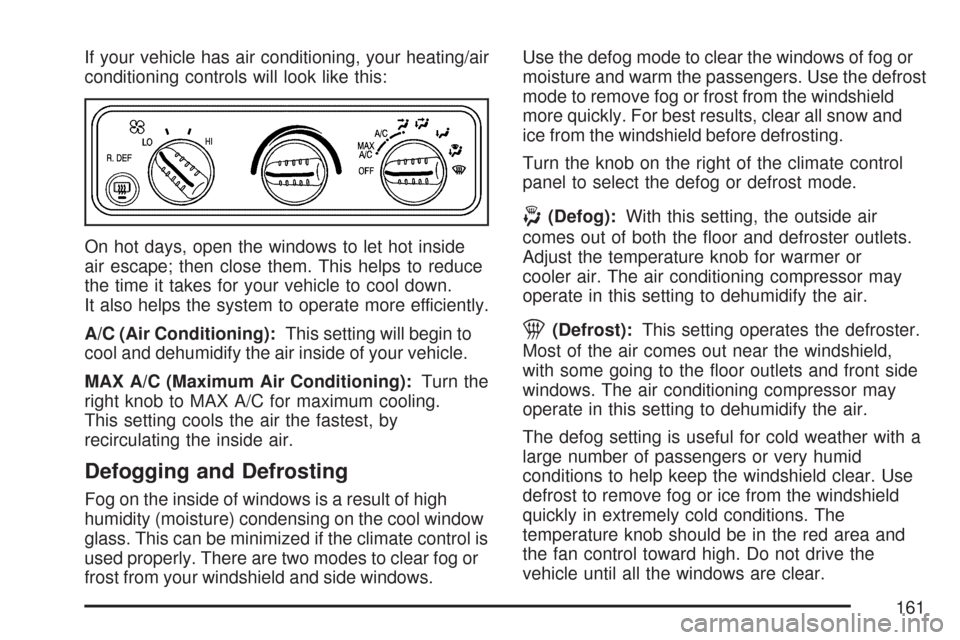
If your vehicle has air conditioning, your heating/air
conditioning controls will look like this:
On hot days, open the windows to let hot inside
air escape; then close them. This helps to reduce
the time it takes for your vehicle to cool down.
It also helps the system to operate more efficiently.
A/C (Air Conditioning):This setting will begin to
cool and dehumidify the air inside of your vehicle.
MAX A/C (Maximum Air Conditioning):Turn the
right knob to MAX A/C for maximum cooling.
This setting cools the air the fastest, by
recirculating the inside air.
Defogging and Defrosting
Fog on the inside of windows is a result of high
humidity (moisture) condensing on the cool window
glass. This can be minimized if the climate control is
used properly. There are two modes to clear fog or
frost from your windshield and side windows.Use the defog mode to clear the windows of fog or
moisture and warm the passengers. Use the defrost
mode to remove fog or frost from the windshield
more quickly. For best results, clear all snow and
ice from the windshield before defrosting.
Turn the knob on the right of the climate control
panel to select the defog or defrost mode.
-(Defog):With this setting, the outside air
comes out of both the floor and defroster outlets.
Adjust the temperature knob for warmer or
cooler air. The air conditioning compressor may
operate in this setting to dehumidify the air.
1(Defrost):This setting operates the defroster.
Most of the air comes out near the windshield,
with some going to the floor outlets and front side
windows. The air conditioning compressor may
operate in this setting to dehumidify the air.
The defog setting is useful for cold weather with a
large number of passengers or very humid
conditions to help keep the windshield clear. Use
defrost to remove fog or ice from the windshield
quickly in extremely cold conditions. The
temperature knob should be in the red area and
the fan control toward high. Do not drive the
vehicle until all the windows are clear.
161
Page 163 of 458
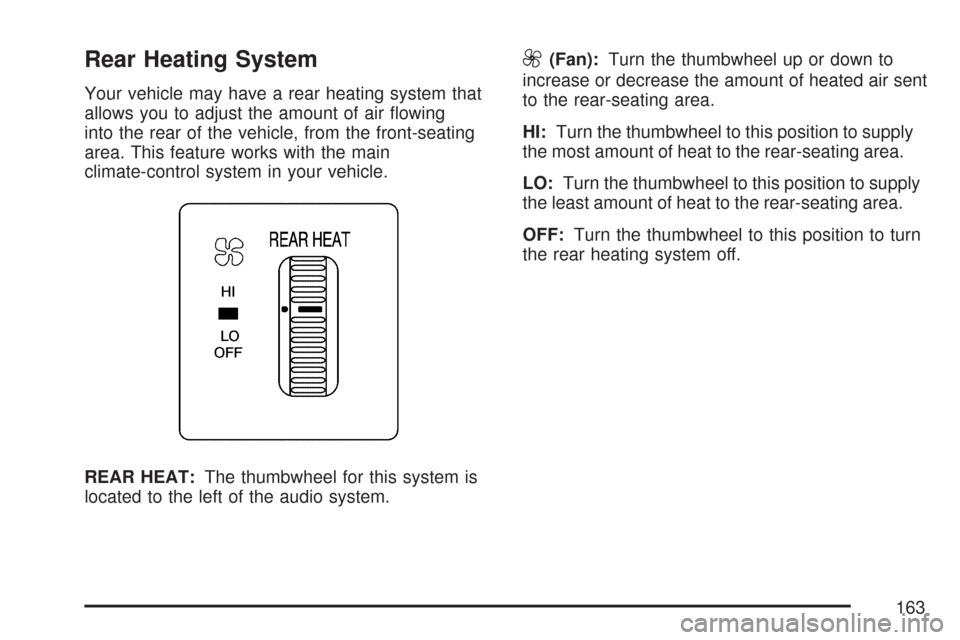
Rear Heating System
Your vehicle may have a rear heating system that
allows you to adjust the amount of air flowing
into the rear of the vehicle, from the front-seating
area. This feature works with the main
climate-control system in your vehicle.
REAR HEAT:The thumbwheel for this system is
located to the left of the audio system.
9(Fan):Turn the thumbwheel up or down to
increase or decrease the amount of heated air sent
to the rear-seating area.
HI:Turn the thumbwheel to this position to supply
the most amount of heat to the rear-seating area.
LO:Turn the thumbwheel to this position to supply
the least amount of heat to the rear-seating area.
OFF:Turn the thumbwheel to this position to turn
the rear heating system off.
163
Page 164 of 458
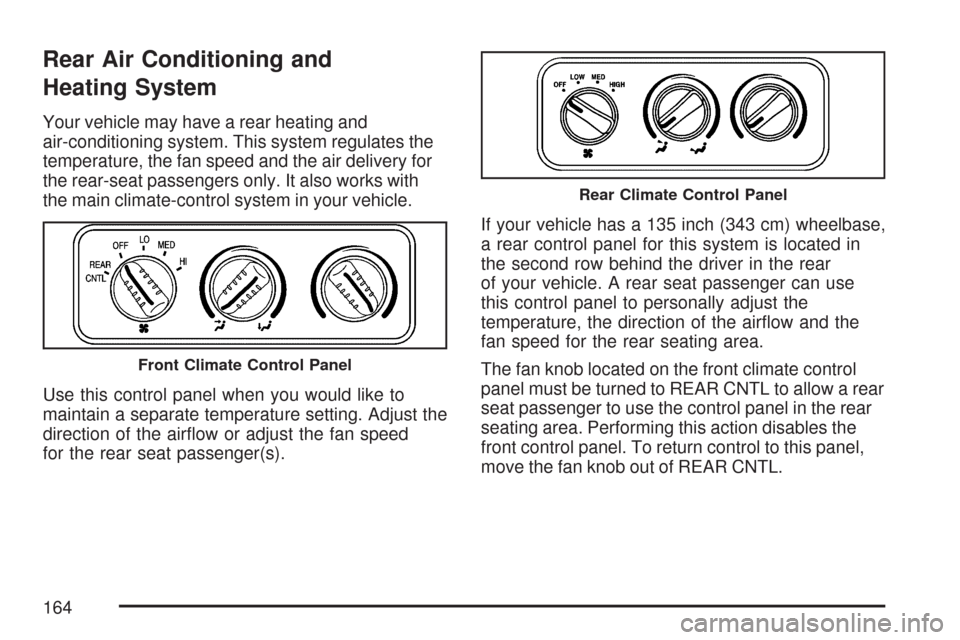
Rear Air Conditioning and
Heating System
Your vehicle may have a rear heating and
air-conditioning system. This system regulates the
temperature, the fan speed and the air delivery for
the rear-seat passengers only. It also works with
the main climate-control system in your vehicle.
Use this control panel when you would like to
maintain a separate temperature setting. Adjust the
direction of the airflow or adjust the fan speed
for the rear seat passenger(s).If your vehicle has a 135 inch (343 cm) wheelbase,
a rear control panel for this system is located in
the second row behind the driver in the rear
of your vehicle. A rear seat passenger can use
this control panel to personally adjust the
temperature, the direction of the airflow and the
fan speed for the rear seating area.
The fan knob located on the front climate control
panel must be turned to REAR CNTL to allow a rear
seat passenger to use the control panel in the rear
seating area. Performing this action disables the
front control panel. To return control to this panel,
move the fan knob out of REAR CNTL.
Front Climate Control Panel
Rear Climate Control Panel
164
Page 178 of 458

Engine Coolant Temperature Gage
This gage shows the engine coolant temperature.
If the gage pointer moves into the red area
your engine is too hot!
It means that your engine coolant has overheated.
If you have been operating your vehicle under
normal operating conditions, you should pull off the
road, stop your vehicle, and turn off the engine
as soon as possible.
SeeEngine Overheating on page 315.
Malfunction Indicator Lamp
Check Engine Light
Your vehicle has a
computer which
monitors operation of
the fuel, ignition, and
emission control
systems.
This system is called OBD II (On-Board
Diagnostics-Second Generation) and is intended
to assure that emissions are at acceptable
levels for the life of the vehicle, helping to produce
a cleaner environment. The Check Engine light
comes on to indicate that there is a problem and
service is required. Malfunctions often will be
indicated by the system before any problem is
apparent. This may prevent more serious damage
to your vehicle. This system is also designed to
assist your service technician in correctly
diagnosing any malfunction.
United StatesCanada
178